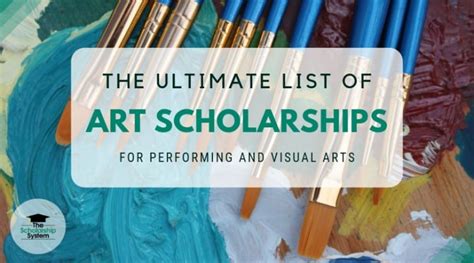
Aspiring artists, are you searching for ways to fund your passion? Art scholarships offer a lifeline to talented individuals, providing financial assistance and recognition for their artistic endeavors. Yet, navigating the scholarship landscape can be daunting. This comprehensive guide will empower you to uncover hidden gems, master the application process, and secure the support you need to elevate your artistic journey.
Types of Art Scholarships: A World of Opportunities
The world of art scholarships is vast and diverse, offering a myriad of opportunities for aspiring artists to pursue their creative aspirations. These scholarships vary in scope, eligibility criteria, and award amounts, catering to a wide range of students and their unique artistic endeavors.
Undergraduate Art Scholarships
Undergraduate art scholarships are designed to support students during their undergraduate studies in art-related fields. These scholarships often consider factors such as academic merit, artistic talent, and financial need. They provide financial assistance for tuition, fees, supplies, and other expenses associated with pursuing an undergraduate degree in art.
Graduate Art Scholarships
Graduate art scholarships are intended for students pursuing advanced degrees in art. These scholarships are highly competitive and typically require a strong academic record, a portfolio of exceptional artwork, and a well-defined research proposal. Graduate art scholarships provide financial support for tuition, fees, living expenses, and research costs.
International Art Scholarships
International art scholarships are open to students from outside the artist’s home country. These scholarships are offered by universities, art organizations, and governments to support international students pursuing art education. International art scholarships often cover tuition, fees, living expenses, and travel costs.
Need-Based Art Scholarships
Need-based art scholarships are awarded to students who demonstrate financial need and a commitment to pursuing an art education. These scholarships consider factors such as family income, assets, and other financial circumstances. Need-based art scholarships provide financial assistance to make art education accessible to students from all socioeconomic backgrounds.
Merit-Based Art Scholarships
Merit-based art scholarships are awarded to students who demonstrate exceptional artistic talent and academic achievement. These scholarships are highly competitive and typically require a strong portfolio of artwork, a high GPA, and letters of recommendation from art instructors or professionals.
Art Department Scholarships
Art department scholarships are offered by individual art departments at universities and colleges. These scholarships are awarded to students who are enrolled in the art department and who demonstrate talent, dedication, and academic achievement. Art department scholarships often provide financial assistance for tuition, fees, supplies, and travel expenses.
Finding Art Scholarships: Uncovering Hidden Gems
The key to successfully securing art scholarships lies in meticulous research and a proactive approach. Aspiring artists should explore various resources to uncover scholarships that align with their artistic interests, financial needs, and academic qualifications.
University and College Websites
University and college websites often have dedicated pages that list available scholarships for art students. These websites provide detailed information about eligibility criteria, application deadlines, and the selection process. Students should thoroughly review these pages to identify potential opportunities.
Art Organizations and Foundations
Numerous art organizations and foundations offer scholarships to support aspiring artists. These organizations may have specific criteria, such as a focus on a particular art medium or a commitment to community engagement. Students should research these organizations and explore their scholarship programs.
Online Scholarship Search Engines
Online scholarship search engines are valuable tools for finding art scholarships. These websites gather information from various sources and allow students to search for scholarships based on their specific criteria. Students should utilize these search engines to broaden their search and identify scholarships they may not have otherwise discovered.
High School Counselors and Art Teachers
High school counselors and art teachers are often aware of local and national art scholarships. They can provide guidance and support to students as they navigate the scholarship search process. Students should reach out to their counselors and teachers for information and recommendations.
Networking and Referrals
Networking with art professionals, attending art events, and joining art organizations can lead to valuable connections. These connections may provide information about scholarship opportunities not widely advertised. Students should actively network and seek referrals from individuals within the art community.
Applying for Art Scholarships: Mastering the Process
Applying for art scholarships requires careful preparation and attention to detail. Students should approach the application process strategically to increase their chances of success.
Eligibility Criteria
Before applying for an art scholarship, it is crucial to thoroughly review the eligibility criteria. Students should ensure that they meet all the requirements, such as academic standing, artistic experience, and financial need. Failure to meet the eligibility criteria will result in disqualification.
Application Materials
Art scholarship applications typically require various materials, including a portfolio of artwork, a personal statement, letters of recommendation, and transcripts. Students should carefully prepare each component of their application, ensuring that it showcases their artistic abilities and commitment to their studies.
Portfolio Presentation
The art portfolio is a central component of an art scholarship application. It provides the scholarship committee with a visual representation of the student’s artistic skills and potential. Students should select their strongest artwork for their portfolio and present it in a cohesive and professional manner.
Personal Statement
The personal statement is an opportunity for students to articulate their artistic vision, goals, and aspirations. It should be well-written and convey the student’s passion for art and their commitment to pursuing their artistic aspirations.
Letters of Recommendation
Letters of recommendation provide external validation of the student’s artistic abilities and character. Students should request letters of recommendation from art instructors, mentors, or professionals who can attest to their talent and work ethic.
Interviewing for Art Scholarships: Tips for Success
If shortlisted for an art scholarship, students may be invited to participate in an interview. The interview is an opportunity for the scholarship committee to further assess the student’s artistic abilities, motivation, and character.
Preparation
Preparation is key to a successful interview. Students should research the scholarship and the institution offering it. They should also prepare answers to common interview questions and practice articulating their artistic vision and goals.
Professionalism
During the interview, it is essential to maintain a professional demeanor. Students should dress appropriately, arrive on time, and be polite and respectful to the interviewers.
Enthusiasm and Confidence
Interviewers are looking for students who are passionate about art and confident in their abilities. Students should convey their enthusiasm for their work and demonstrate a clear understanding of their artistic goals.
Communication Skills
Effective communication skills are crucial during an interview. Students should be able to articulate their thoughts clearly and concisely. They should also be able to listen attentively and respond thoughtfully to the interviewers’ questions.
Questions for the Interviewers
At the end of the interview, students should prepare thoughtful questions to ask the interviewers. This demonstrates their engagement and interest in the scholarship and the institution.
Art Scholarship Awards: Recognizing Excellence
Art scholarship awards are a testament to the exceptional talent and dedication of aspiring artists. These awards provide financial support, recognition, and validation, enabling students to pursue their artistic endeavors with confidence and passion.
Award Amounts and Benefits
Art scholarship awards vary in amount and benefits. Some scholarships provide full tuition coverage, while others offer partial financial assistance or support for specific expenses such as supplies, travel, or research costs.
Recognition and Prestige
Winning an art scholarship brings recognition and prestige to the recipient. It demonstrates the student’s artistic abilities and potential, opening doors to future opportunities and collaborations.
Professional Development and Networking
Art scholarship awards often include opportunities for professional development and networking. Recipients may have access to workshops, mentorship programs, and connections with established artists and art professionals.
Inspiration and Motivation
Receiving an art scholarship can be a tremendous source of inspiration and motivation for aspiring artists. It provides a boost of confidence and encourages students to pursue their artistic passions with renewed vigor.
The Benefits of Art Scholarships: Beyond Financial Aid
While financial assistance is a significant benefit of art scholarships, these awards offer a multitude of other advantages that can profoundly impact the lives of aspiring artists.
Reduced Financial Burden
Art scholarships alleviate the financial burden of pursuing an art education. This allows students to focus on their creative endeavors without the added stress of financial concerns.
Increased Access to Opportunities
Art scholarships provide access to opportunities that may not be available otherwise. These opportunities can include workshops, masterclasses, residencies, and travel grants, which can enhance the student’s artistic growth and career prospects.
Validation and Confidence
Winning an art scholarship is a form of validation and recognition. It boosts the student’s confidence in their abilities and encourages them to pursue their artistic aspirations with greater determination.
Mentorship and Support
Some art scholarships include mentorship or support from established artists or art professionals. This guidance can be invaluable for aspiring artists, providing them with advice, encouragement, and connections within the art world.
Prestige and Recognition
Winning an art scholarship brings recognition and prestige to the recipient. It demonstrates the student’s talent and potential, showcasing their work to a wider audience and opening doors to future opportunities.
Art Scholarships for Undergraduates: A Catalyst for Early Careers
Art scholarships for undergraduates provide a vital foundation for aspiring artists at the outset of their careers. These scholarships support students as they develop their artistic skills, explore different mediums, and lay

